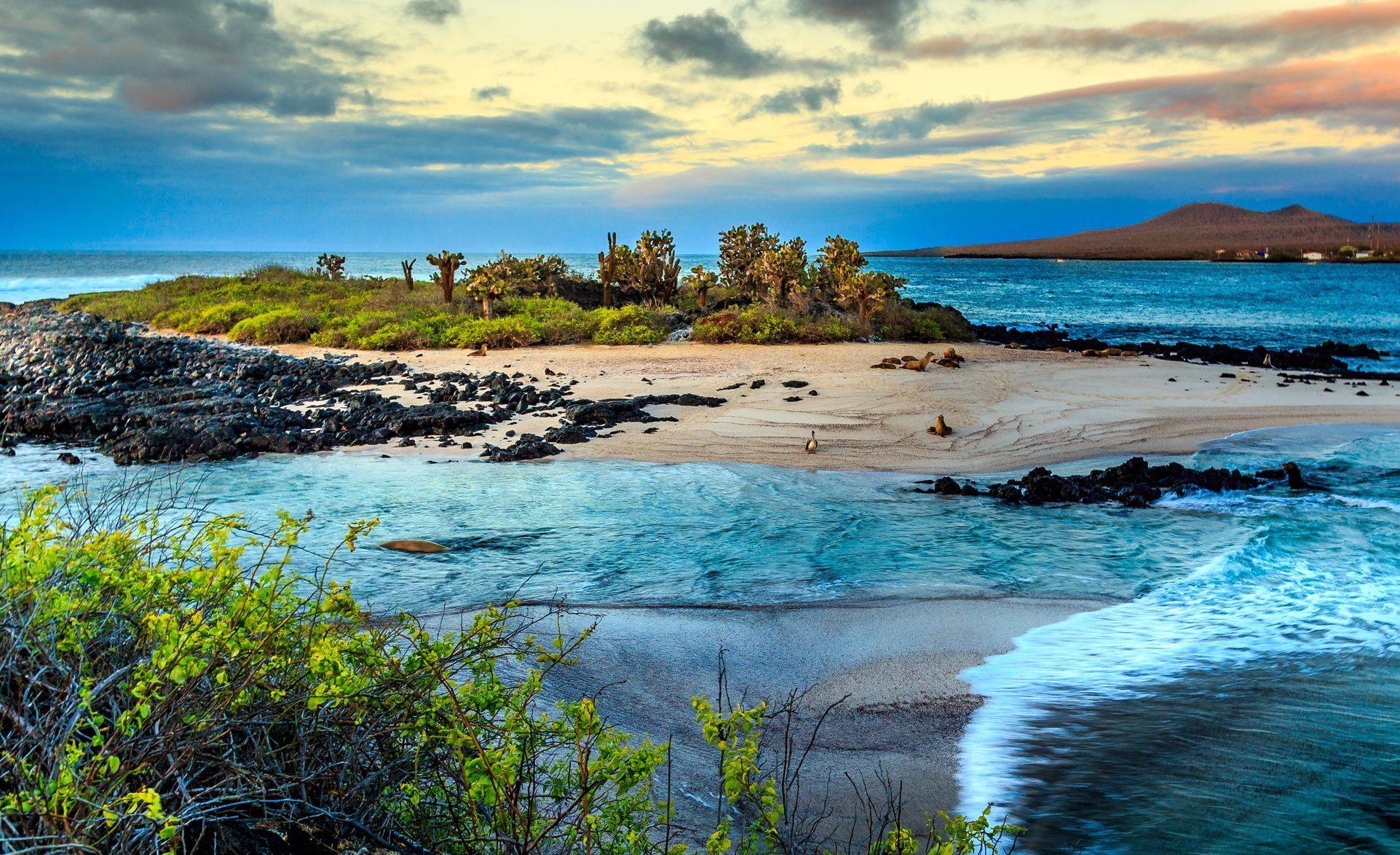The Galapagos Islands are a volcanic archipelago located 621 miles, 1000km, from the coast of Ecuador. The younger, more westerly islands - such as Isabela and Bartolome - are renowned for their otherworldly lava landscapes and volcanic peaks. They are also known for their gorgeous white sand beaches. Meanwhile, the older islands of the eastern Galapagos are more verdant.
The Galapagos Islands are known for being one of the best wildlife watching sites in the world. They are home to a large number of endemic species (animals that you can't see anywhere else in the world), including the Galapagos giant tortoise, the Galapagos fur seal and the Galapagos penguin. Due to their position at the convergence between three major ocean currents, the clear waters surrounding the islands are home to a wide diversity of marine species, from golden rays to hammerhead sharks.
"It’s like a paradise here on earth," says Quito-based destination expert Henry Sisa. "In the Galapagos, there are two incredible ways to discover animals. One is by walking, and the other one is snorkelling. Half of the wildlife you will see in the Galapagos is by land and maybe the other half is marine wildlife."
It’s like a paradise here on earth
In this Galapagos wildlife guide, we explore the reasons why the wildlife here is so unique, and look at some of the most charismatic species who live on the islands. We also look at the different wildlife spectacles you can witness on a month by month basis, as well as exploring the best wildlife-themed activities the archipelago has to offer.
Of course, sightings of a certain species are never guaranteed - animals march to the beat of their own drum, not to ours. But part of the joy of a wildlife watching holiday is about those unexpected, unscripted animal encounters. Wildlife watching responsibly is very important, something tour operators in the Galapagos Islands are very aware of. In fact, only 3% of the Galapagos National Park area is open to tourists, keeping the rest pristine for its animal inhabitants.
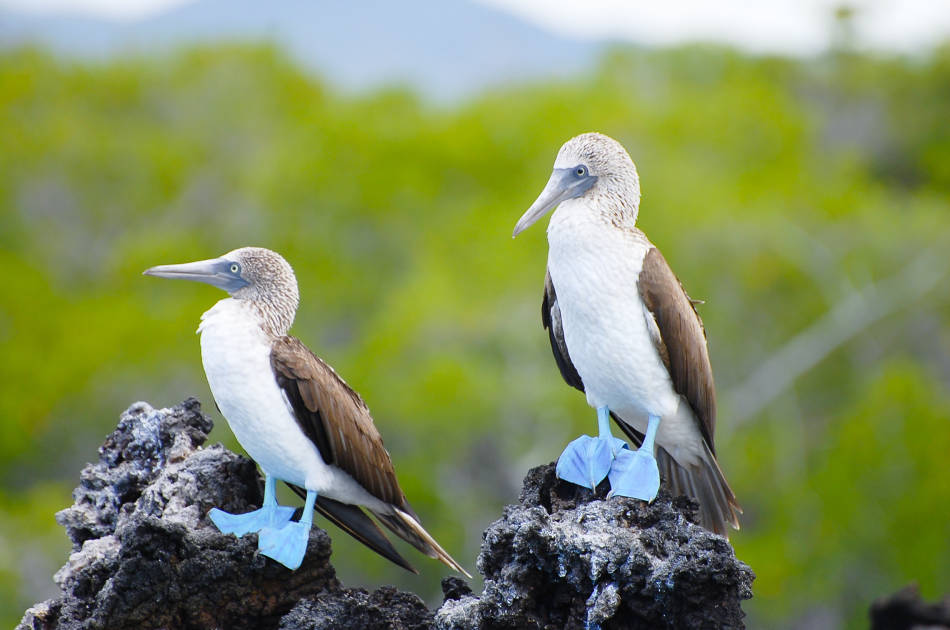
What Makes the Galapagos Islands Wildlife Unique?
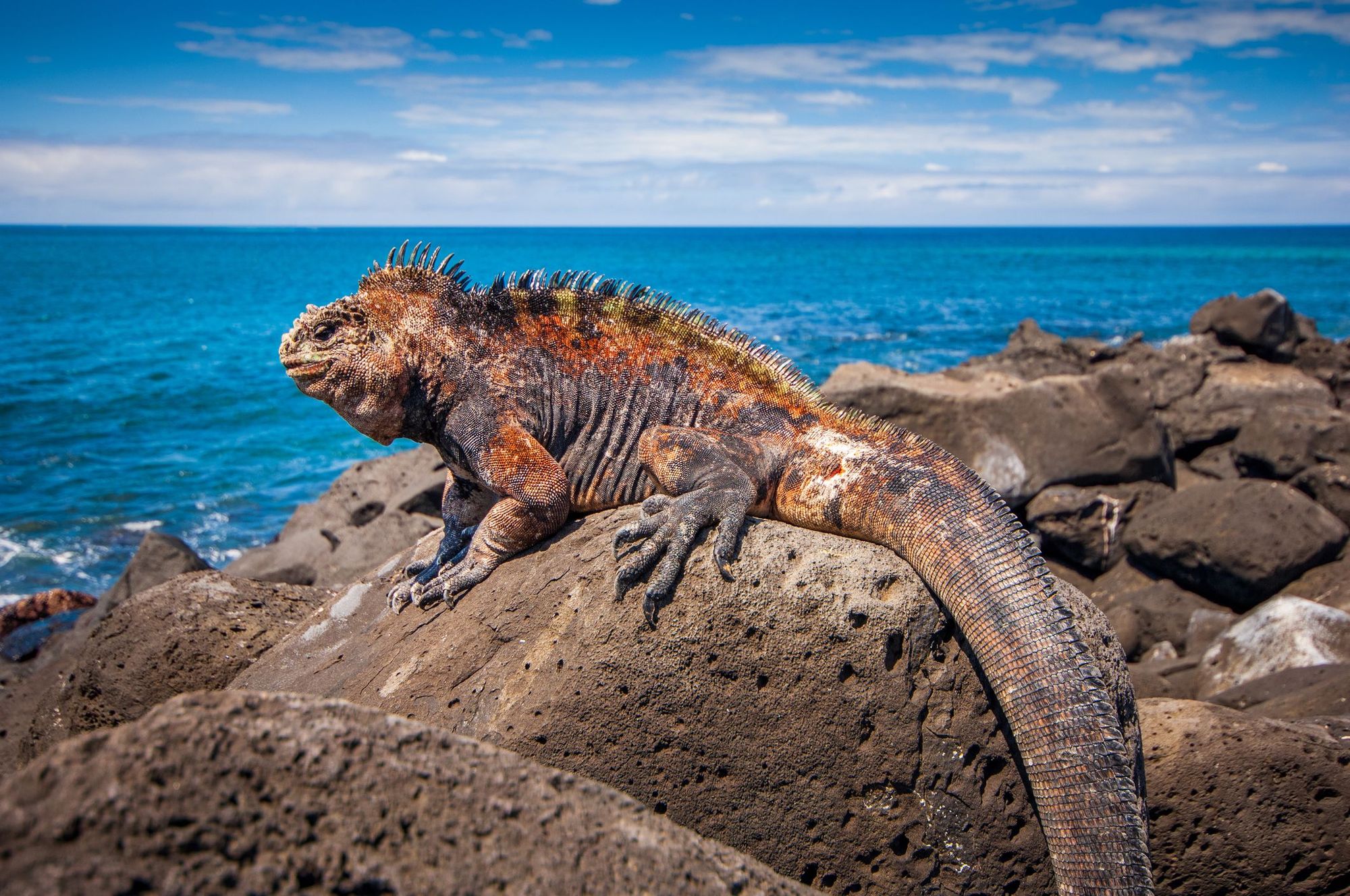
The Galapagos Islands were created between five and 10 million years ago, the result of underwater volcanoes. When they emerged from the ocean, these volcanic cones were completely devoid of plant and animal life. Despite the geographical location of the islands, they would eventually become home to a variety of unusual species.
The ancestors of some present-day Galapagos Islands animals - such as sea lions and penguins - would have swum to the islands, while birds would have flown there. It’s believed that reptiles and smaller mammals (such as rice rats) would have travelled to the islands from the South or Central American mainland on rafts of vegetation. Although this sounds unlikely, you would only need a small handful of each species to arrive onshore to create a stable population. This “raft theory” also explains why there is a high number of reptiles and few mammals on the islands - the former are better adapted to the conditions of spending weeks at sea.
It’s believed that reptiles and smaller mammals (such as rice rats) would have travelled to the islands from the South or Central American mainland on rafts of vegetation
There are high levels of endemism on the Galapagos Islands - around 80% of the land birds, 20% of the marine species and 97% of the reptiles and land mammals are found only on the Galapagos. There are two reasons for this : the islands’ geographic isolation from the mainland and from each other; and the distinct climatic and habitat variations on individual islands. Animals evolve to suit their environment, and on the Galapagos species have evolved differently to those on neighbouring islands, forming distinct subspecies.
It was Charles Darwin who first discovered this when he visited the islands in 1835, and noticed the species’ variation on different islands. In fact, the Galapagos Islands helped inspire Darwin’s theory of evolution, which put them on the map as one of the world’s most important wildlife sites.

However, since the Galapagos Islands were settled in 1535, it is humans who are now the primary source of plant and animal introductions. Goats and chickens were brought to provide food, domestic cats and dogs were brought over as pets, and ornamental plants were introduced to create gardens. There were also species introduced unintentionally, such as rats and insects. The Galapagos Conservation Trust estimates that there are 1,500 introduced species in the Galapagos Islands.
Unfortunately, endemic species which have evolved in isolation are particularly vulnerable to invasive species. One particular threat is a species of parasitic avian vampire fly, which feeds on eggs and hatchlings. This has led to a decline in many species of Darwin’s finch - the Galapagos Conservation Trust has been working on an effective control plan. Conserving the unique species of the Galapagos - described by UNESCO as a ‘living museum and showcase of evolution’ - is of vital importance.
What Animals Live on the Galapagos Islands?
The Galapagos Islands are home to thousands of different marine species, terrestrial invertebrates and fish. There are fewer land mammals - six in all, five of which are endemic - and reptiles (20 out of 22 species are endemic), as it would have been harder for these species to reach the islands originally. There are 19 different species of seabird, and 29 landbird species, including the famous Darwin’s Finches.
Here are 7 of the islands’ most iconic species.
1. The Galapagos Giant Tortoise
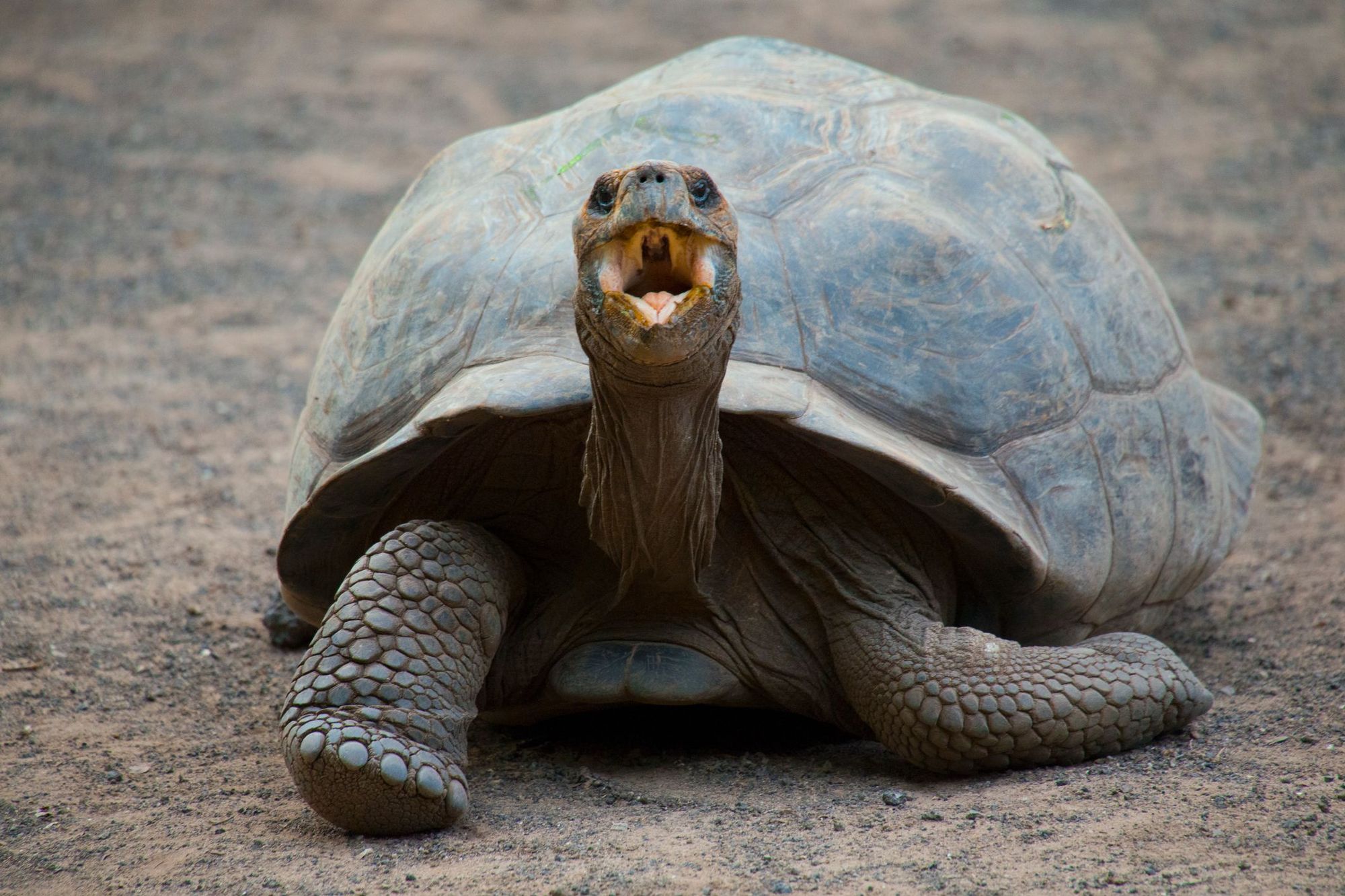
One of the islands’ most well known species is the Galapagos Giant Tortoise - one of only two remaining species of giant tortoise in the world.
Wilson Herrera is an Ecuadorian guide with a wealth of experience working in the Galapagos. "You can observe these magical creatures here in their natural habitat," he says. "They weigh up to 550 pounds and can live for up to 150 years or more, easily passing 100. It's the longest living vertebrate and one of the largest reptiles in the world - but it is also one of the rarest."
Galapagos tortoises grow up to 1.8 metres, and spend up to 16 hours a day resting, and most of the rest of the time finding grasses, fruit and other vegetation to eat.
The giant tortoise is likely to have arrived from the South American mainland between two and three million years ago, and it slowly evolved into 14 slightly different subspecies. Unfortunately, the Floreana tortoise subspecies went extinct in the 19th century, while the last Pinta Island tortoise, Lonesome George, died in 2012. Huge efforts are being made to conserve the remaining 12 subspecies, and there are several turtle reserves on the islands.
2. The Galapagos Penguin
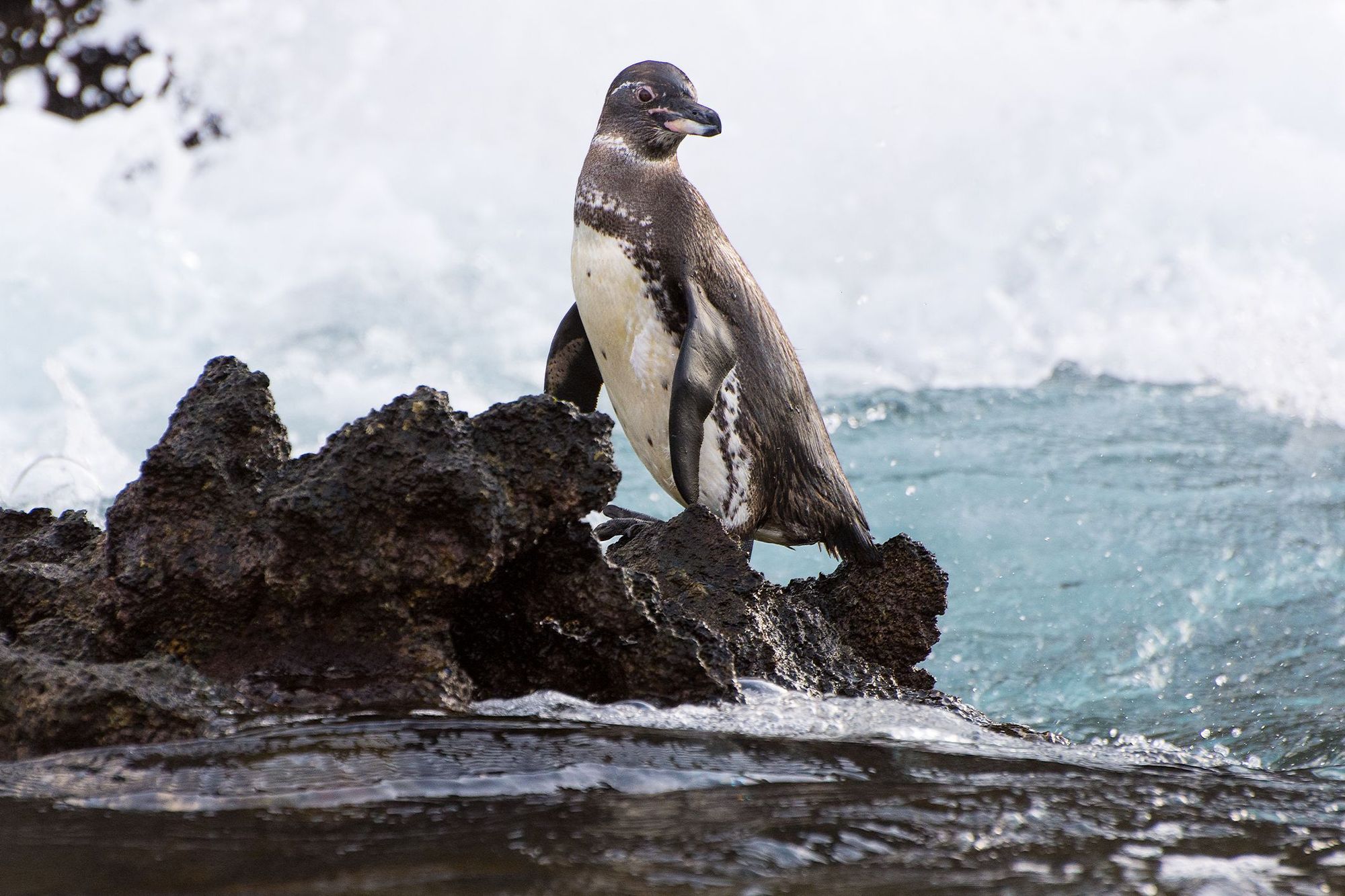
The Galapagos penguin is one of the smallest penguin species in the world, and endemic to the Galapagos. It is also the only penguin that lives north of the equator, thanks to the cool waters around the islands caused by the Humboldt and Cromwell currents.
Galapagos penguins are closely related to the Humboldt and Magellanic penguins, which are burrow dwelling. But there’s no soft soil for them to dig down into, so the Galapagos penguins live in nooks and crannies in the coastal lava.
3. The Galapagos Land Iguana
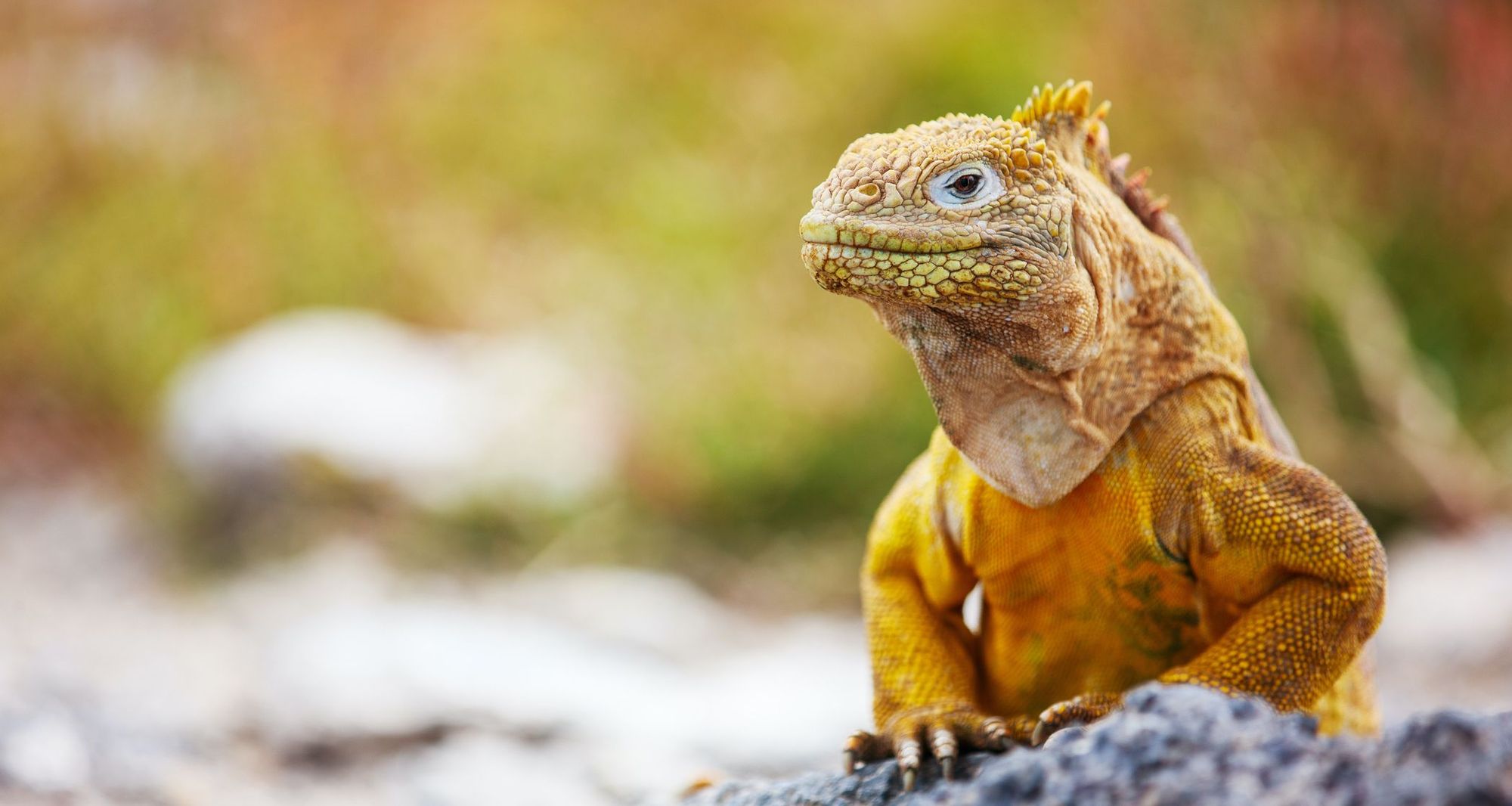
One of three endemic land iguana species (the others are the Galapagos pink land iguana and the Santa Fe land iguana). They grow up to 150 cm in length, and have yellow skin, blotched with white and brown. Despite their sharp claws and dinosaur-like appearance, land iguanas are herbivores, primarily eating prickly pear leaves and fruit.
Galapagos iguanas have a mutualistic relationship with Darwin’s Finches, who pick ticks and other parasites out from between their scales and eat them.
4. Darwin’s Finches
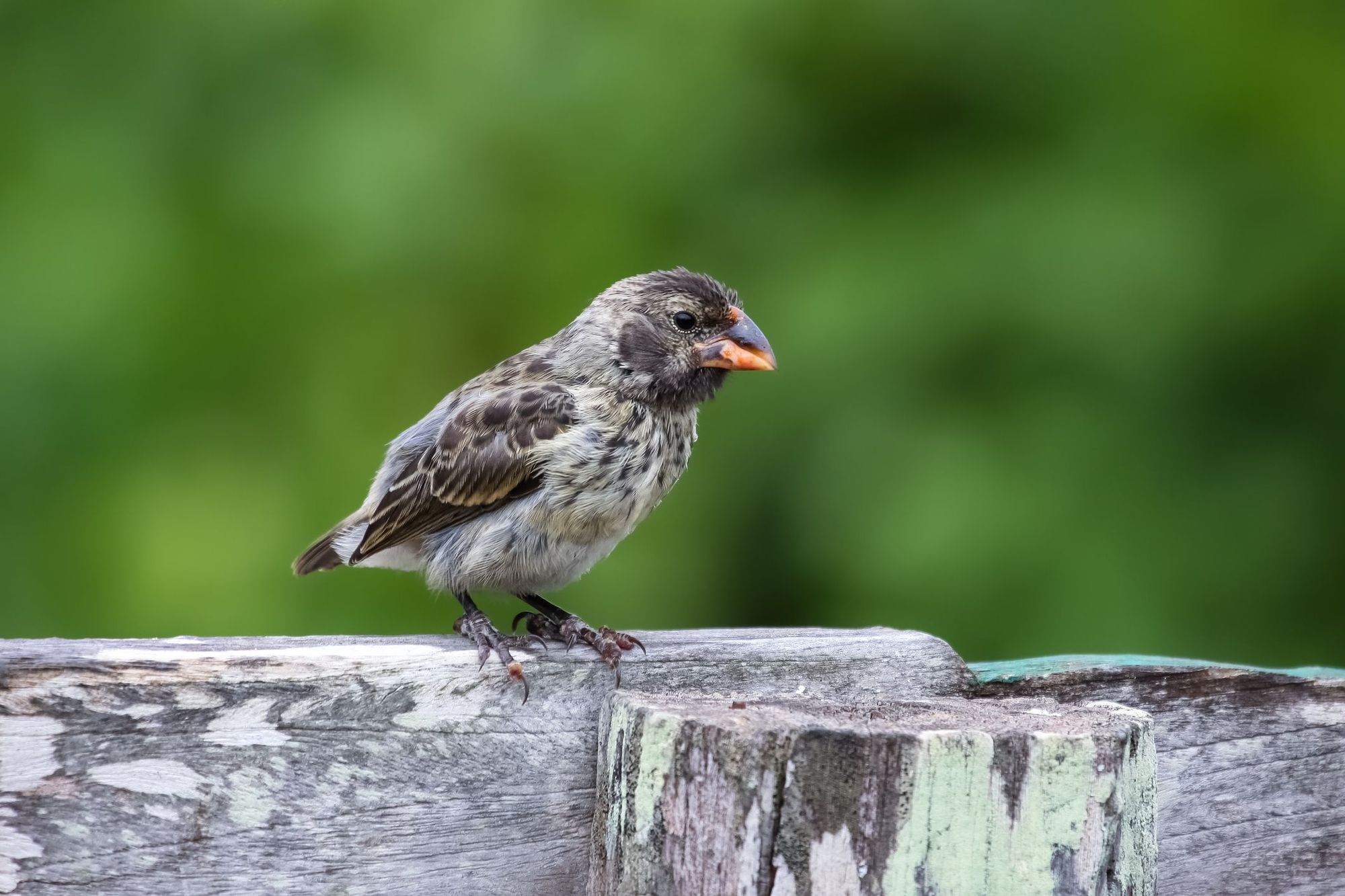
There are 18 different species of Darwin’s Finches on the Galapagos Islands. These small, sandy coloured birds might not be vibrant to look at, but they are important due to their role in Charles Darwin’s theory of evolution. Darwin noticed that although similar in size and colour, the finches had different beak shapes (they had evolved to forage in different environments).
5. The Flightless Cormorant
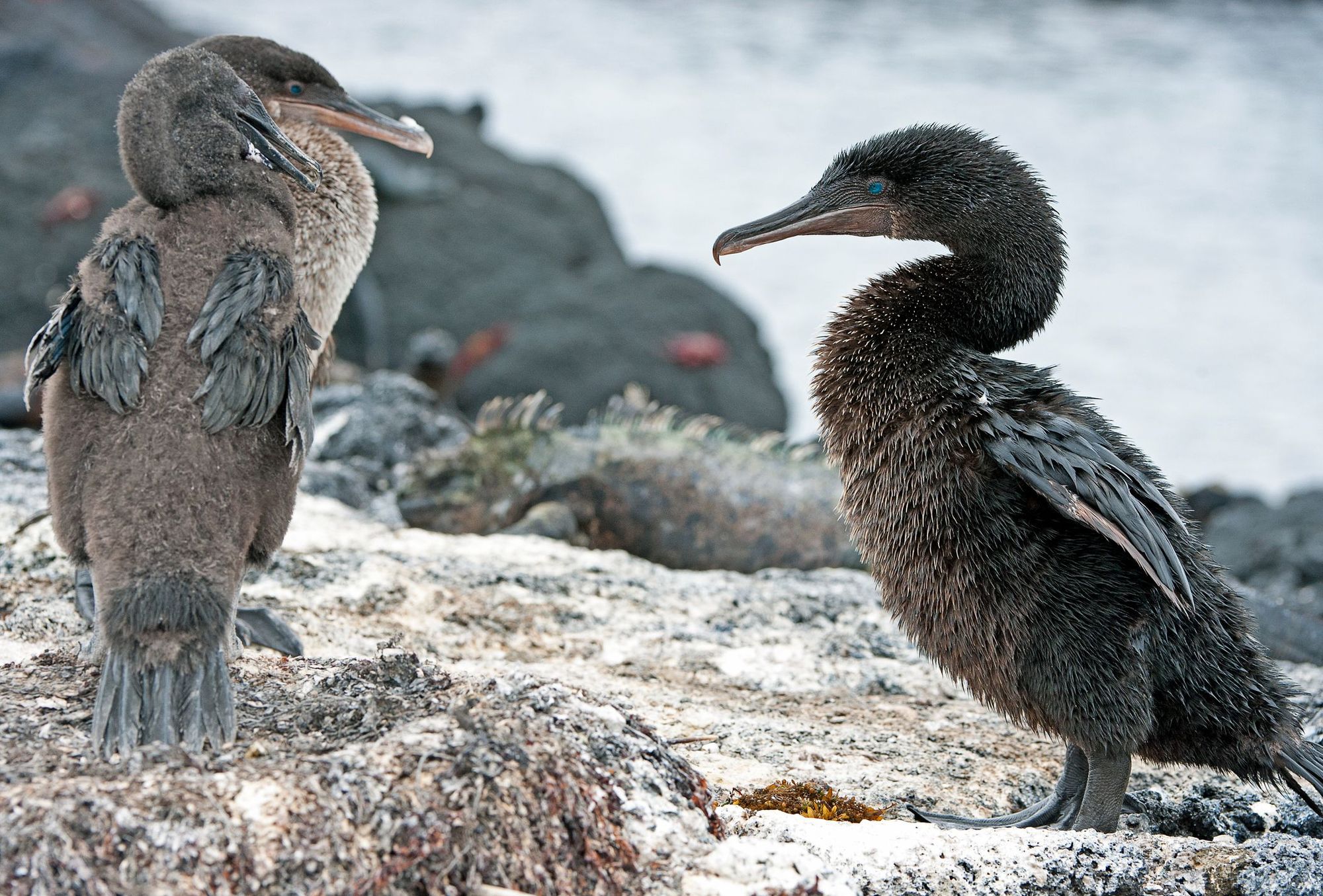
The flightless cormorant, also known as the Galapagos cormorant, is endemic to the islands and the only cormorant species which has evolved not to fly. They have bright turquoise eyes and stunted wings - the latter thanks to natural selection, which favoured individuals better suited to swimming.
These cormorants live on the beaches and shorelines of Isabela and Fernandina, diving deep into the ocean to fish for eel and octopus. They sometimes use their wings for balance when hopping from rock to rock.
6. The Galapagos Fur Seal
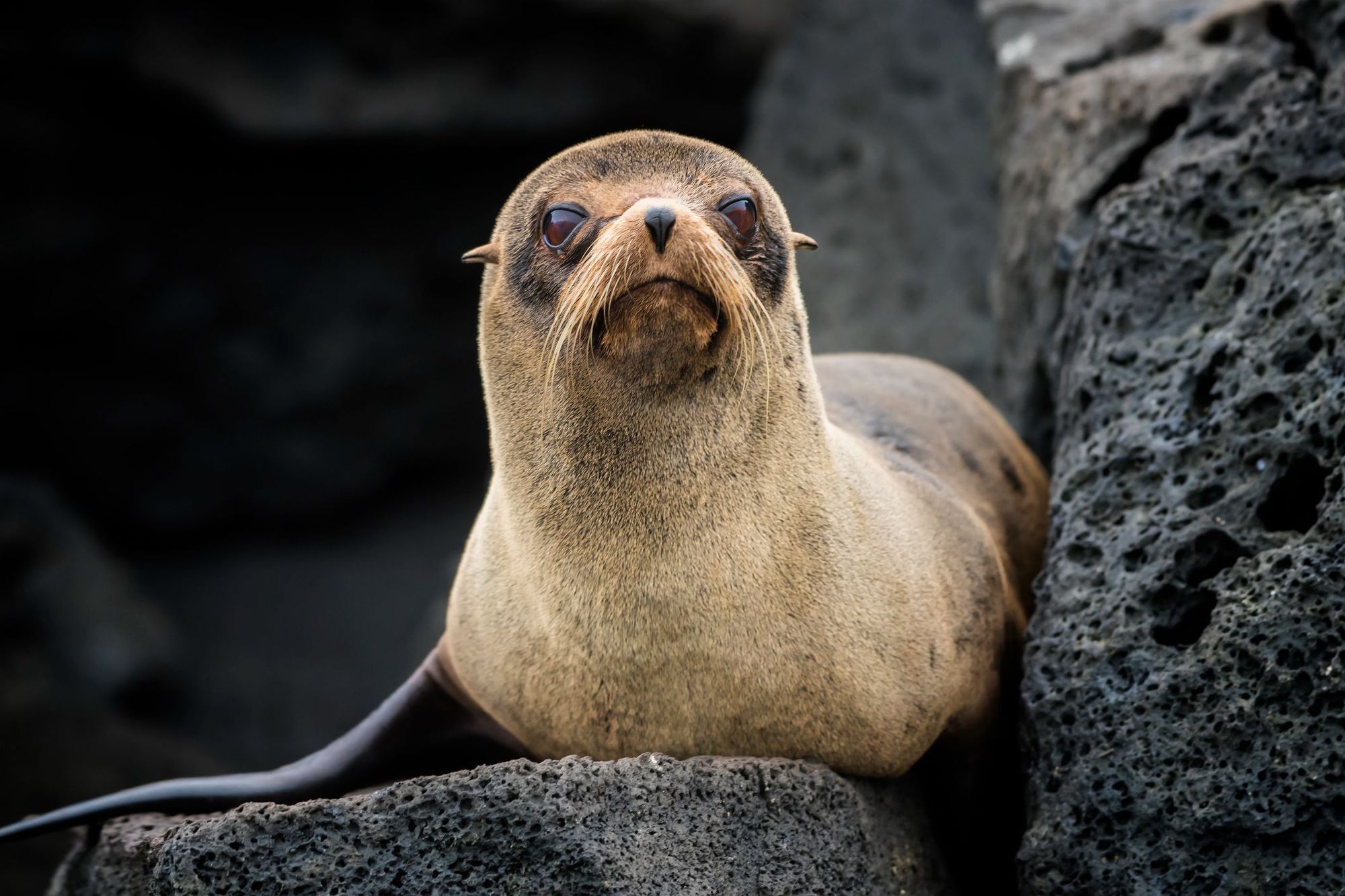
Galapagos fur seals are an endemic species, found on the shores of the western islands in the archipelago. They look similar to the Galapagos sea lion, but have broader heads, larger front flippers and a much thicker greyish-brown fur coat than the sea lions.
Galapagos fur seals are classed as an endangered species by the IUCN, as they were once hunted almost to extinction for their fur. These days, marine plastic pollution and warming sea temperatures (reducing available food) are further threats. They are now protected under Ecuadorian law.
7. The Blue-Footed Booby
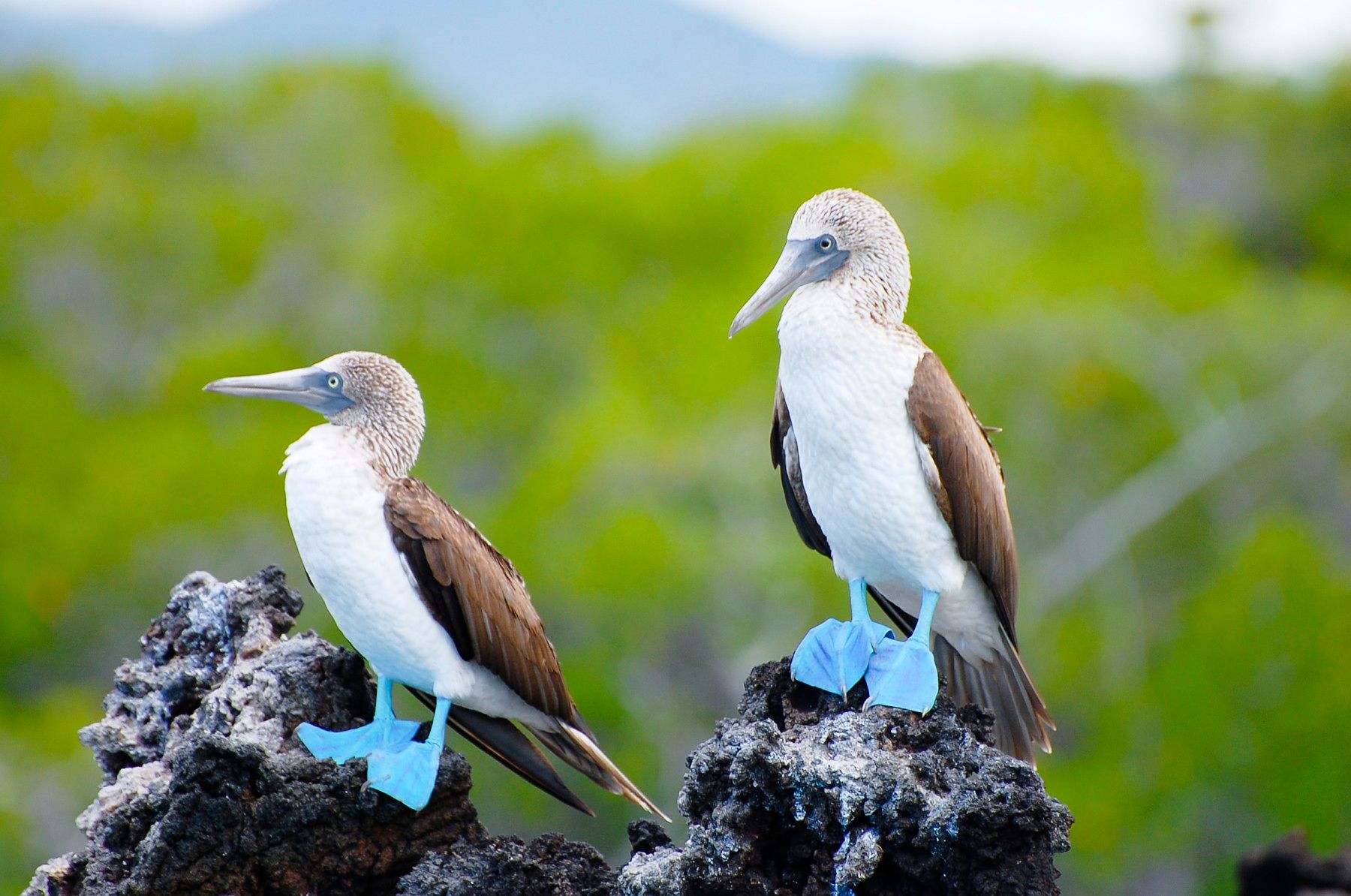
The only non-endemic species on this list, blue-footed boobies are found along the Eastern Pacific coastline. Their name comes from the Spanish ‘bobo’, meaning clown - it refers to their clumsy way of walking.
The most distinctive feature of these birds is their large blue feet - an important feature for courtship, as females are believed to select those males with brighter feet.
The Best Time to See Wildlife in Galapagos: Galapagos Wildlife Month-by-Month
The Galapagos is a year-round destination, with two distinct seasons - the rainy season (December to May) which is hot with intermittent showers, and the cooler dry season (June to November). Reptiles nest and breed during the rainy season, while during the dry season marine life is more active - humpback whales visit the islands in June.
Whatever month you visit, you’ll get to experience the abundance of wildlife the archipelago has to offer. Here’s a month by month guide to some of the key wildlife events of the year.
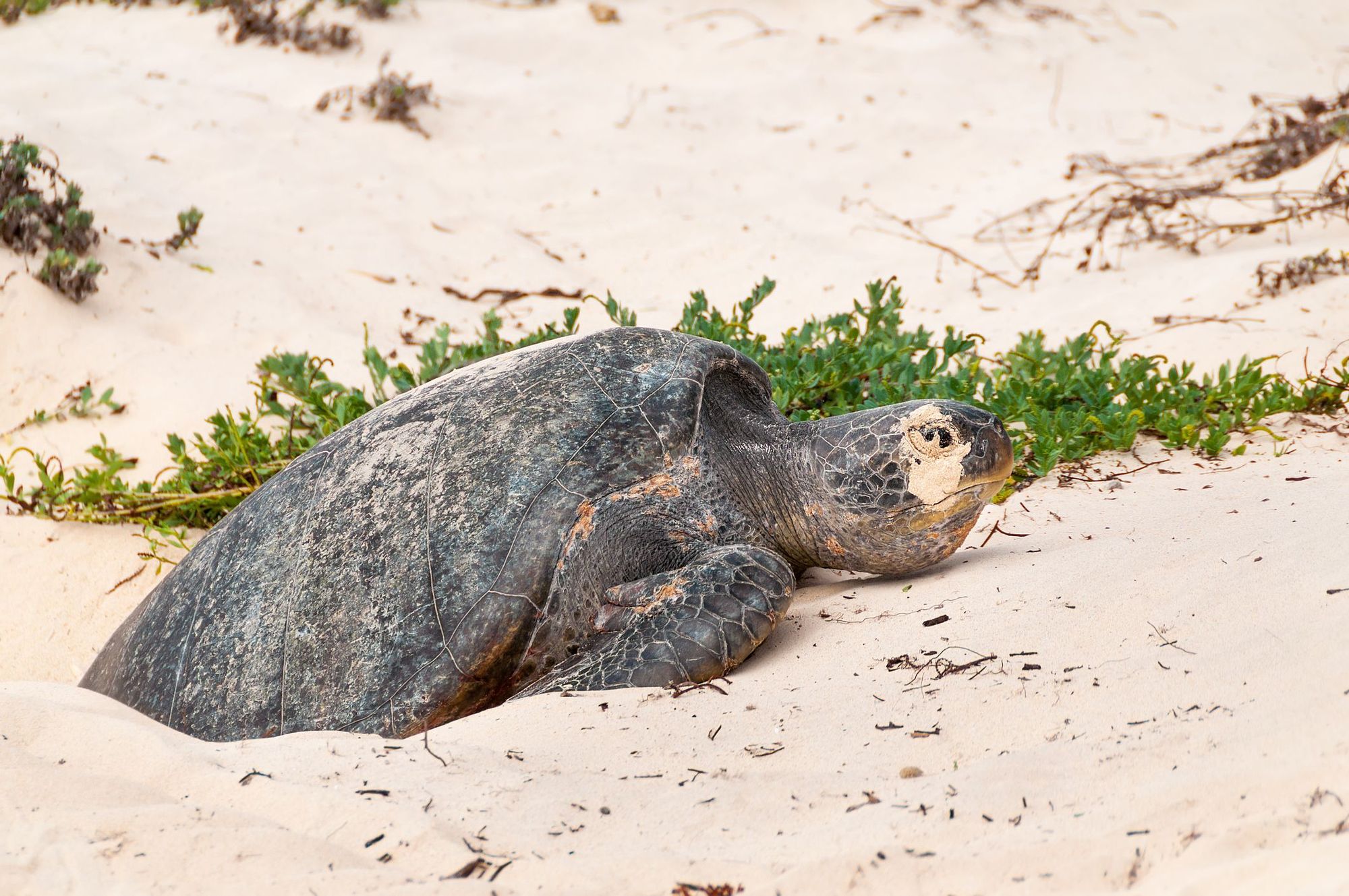
January; Nesting sea turtle, marine iguanas and Darwin's finches
- Darwin’s finches and other land birds begin nesting
- Marine iguanas turn bright green and red
- Galapagos green sea turtles start nesting and laying eggs (until March)
February; Penguins and nesting flamingoes
- Flamingos begin nesting
- Penguins migrate from Bartolome Island to the cooler waters surrounding Isabela and Fernandina.
March; Giant tortoises and nesting iguanas
- Galapagos giant tortoises begin migrating to their nesting sites
- Marine iguanas begin nesting on Fernandina
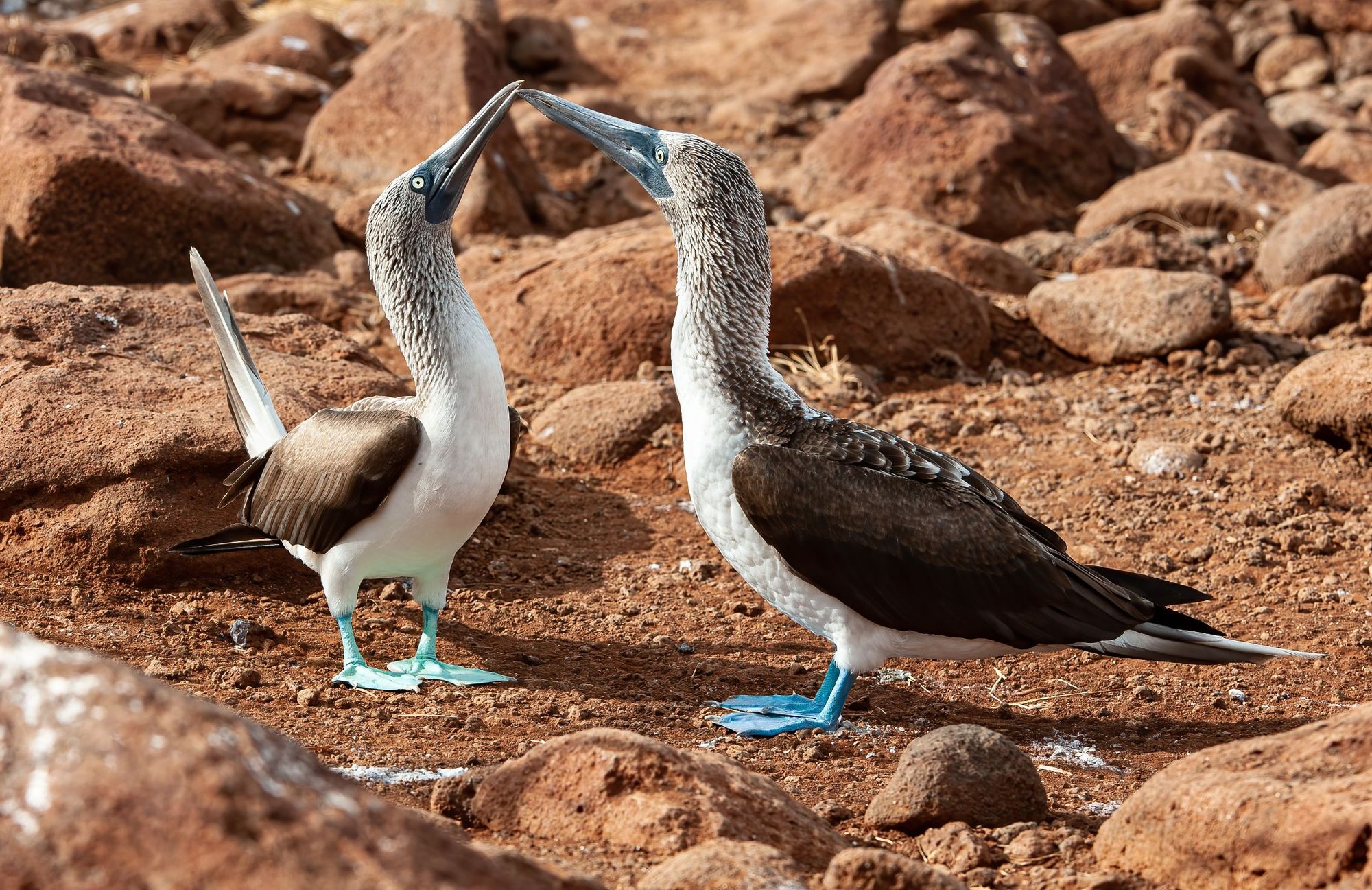
April; Pacific green sea turtles and land iguanas start hatching
- Pacific green sea turtle hatching begins (up to June)
- Galapagos land iguana hatchlings appear
- Blue-footed boobies begin their courtship (up to May)
May; Best for bird-watchers
- Large flocks of Galapagos shearwaters appear
- Waved albatross mate and lay eggs on Española
- Wedge-rumped storm petrels begin nesting on Genovesa
June; Whales, dolphins and birds
- Humpback whales arrive (here until September)
- Blue-footed boobies begin nesting (up to November)
- Whale and dolphins can be seen throughout the islands (until November)
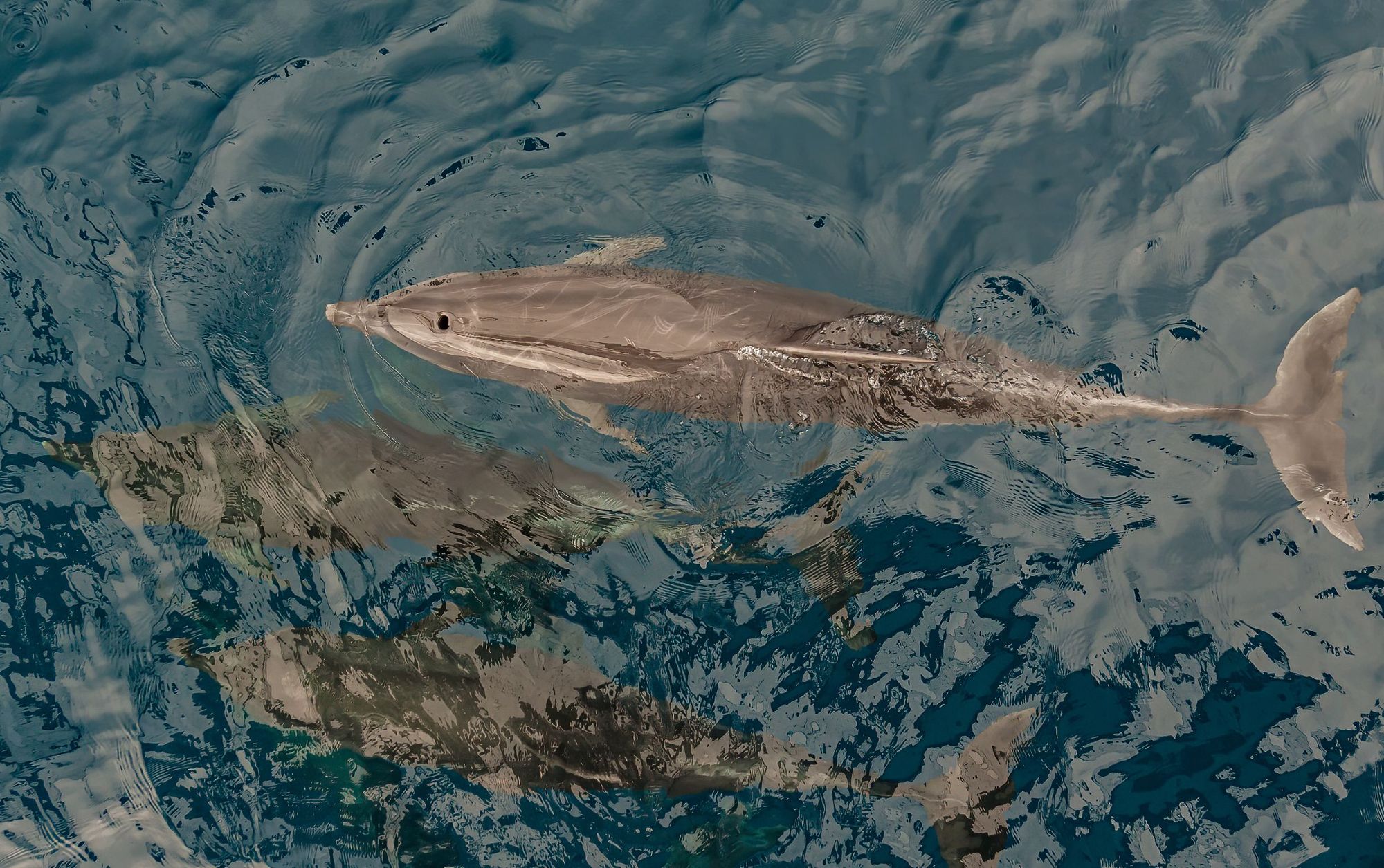
July; Best for seabirds
- Galapagos giant tortoises start their migration back to the Santa Cruz highlands
- Most active season for seabirds
- Flightless cormorants begin their mating ritual
August; Seals, hawks and shorebirds
- Galapagos sea lion and fur seal pups are born (up until November)
- Galapagos hawks have their courtship season on Espanola, Santiago and Fernandina
- Migratory shorebirds, such as rudy turnstones and whimbrels) arrive on the islands
September; Sealions and penguins
- Galapagos sea lions begin their breeding season (until December)
- Penguins begin their courtship season
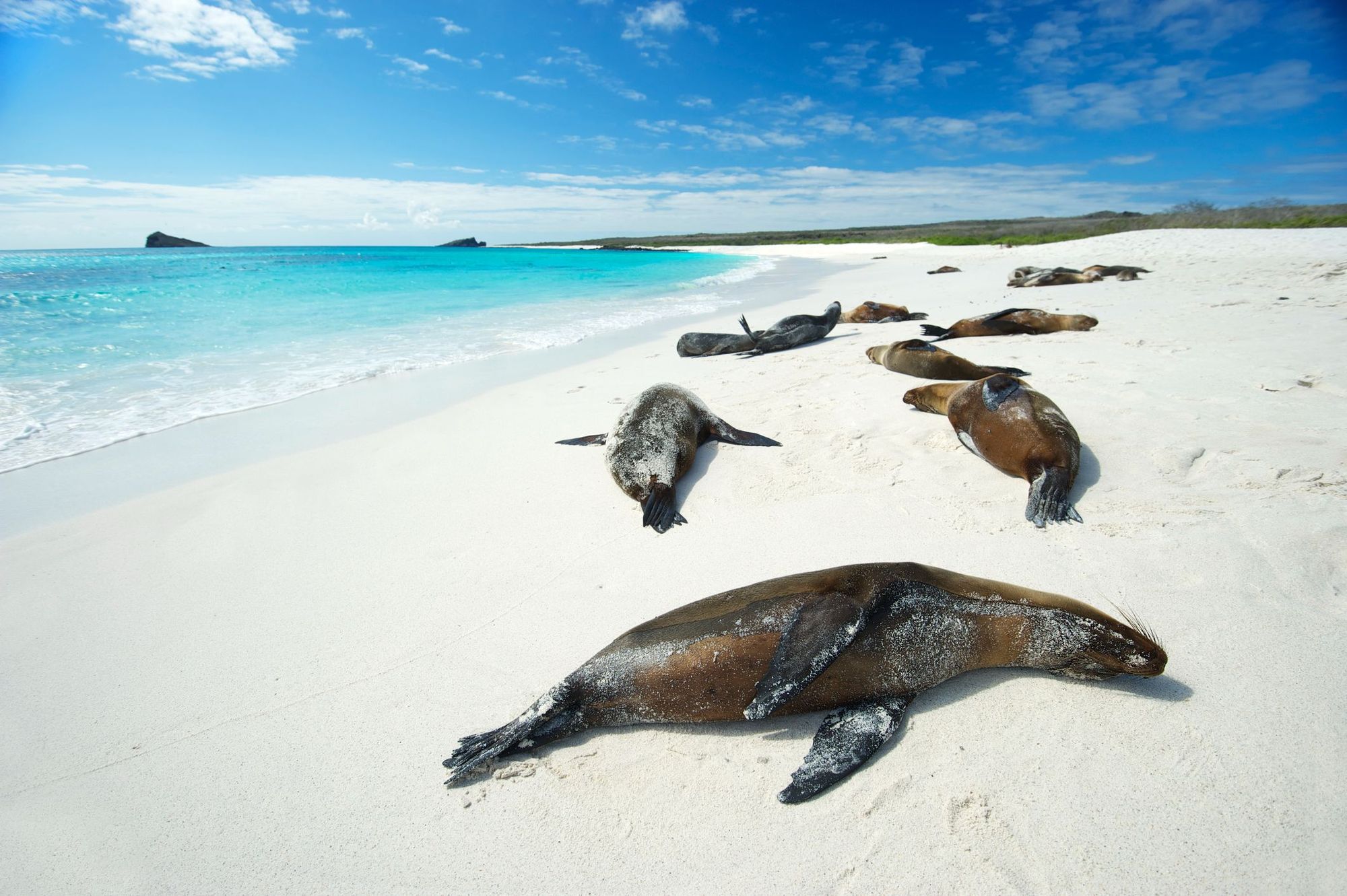
October; Fur seals, giant tortoises and blue footed booby chicks
- Fur seal breeding season begins (and lasts until December) - this is also the best time to see pups
- Blue footed booby chicks are born
- Giant tortoises begin laying their eggs (until November)
November; Sea lions, wedge-rumped storm petrels and pacific green turtles
- Sea lion pups take to the water
- Wedge-rumped storm petrels begin a second nesting season (laying a single egg)
- Pacific green turtles begin their mating season, and are active in the water
December; Whales, dolphins, and marine iguanas
- Waved albatross fledglings appear
- marine iguanas begin their mating season (until February)
- Bryde’s whale can be seen in the western archipelago (until May)
- Bottlenose and common dolphins are abundant in the central and south of the archipelago (until May)
The Best Wildlife-Themed Things to Do in the Galapagos Islands
Just 3% of the Galapagos National Park area is open to tourists, keeping the rest pristine for its animal inhabitants. If you want to experience the wildlife in the Galapagos responsibly, be sure to check out these things to do:
1. Visit the Charles Darwin Research Station
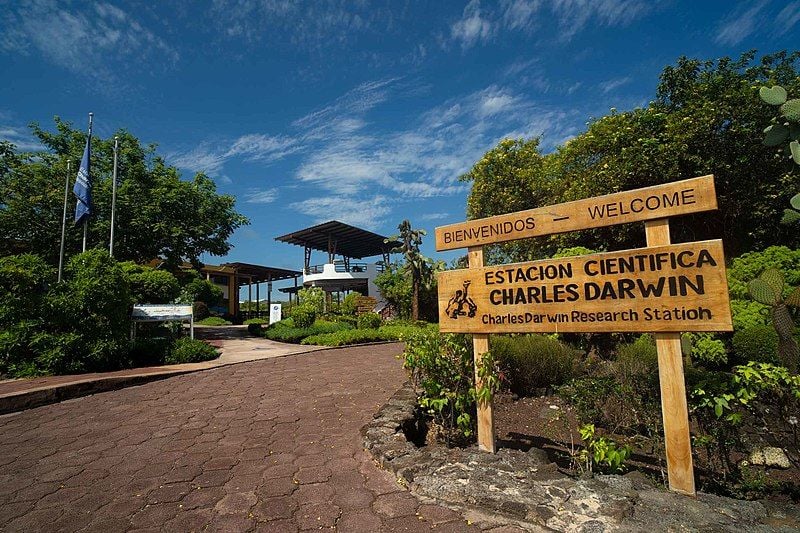
What animals could I see?: Galapagos giant tortoise, Galapagos lava lizard, Galapagos land iguana, Darwin’s finches, Galapagos mockingbird
The Charles Darwin Research Station, in Puerto Ayora on Santa Cruz Island, was established in 1964 as a scientific research base. But it is also a tourist attraction, with an exhibition hall explaining the station’s work, and native gardens that are home to the Galapagos mockingbird, the Galapagos lava lizard and many more.
"You will find a fascinating interpretation center and can wander through the tortoise breeding program facilities," says Wilson.
Entrance to the research station is free, but we recommend paying a small amount for the guided tour, as you’ll get an insight into the research and conservation projects conducted there. You will also be given access to the foundation’s Galapagos giant tortoise breeding centre, the first of its kind on the islands.
2. Explore El Chato Giant Tortoise Reserve
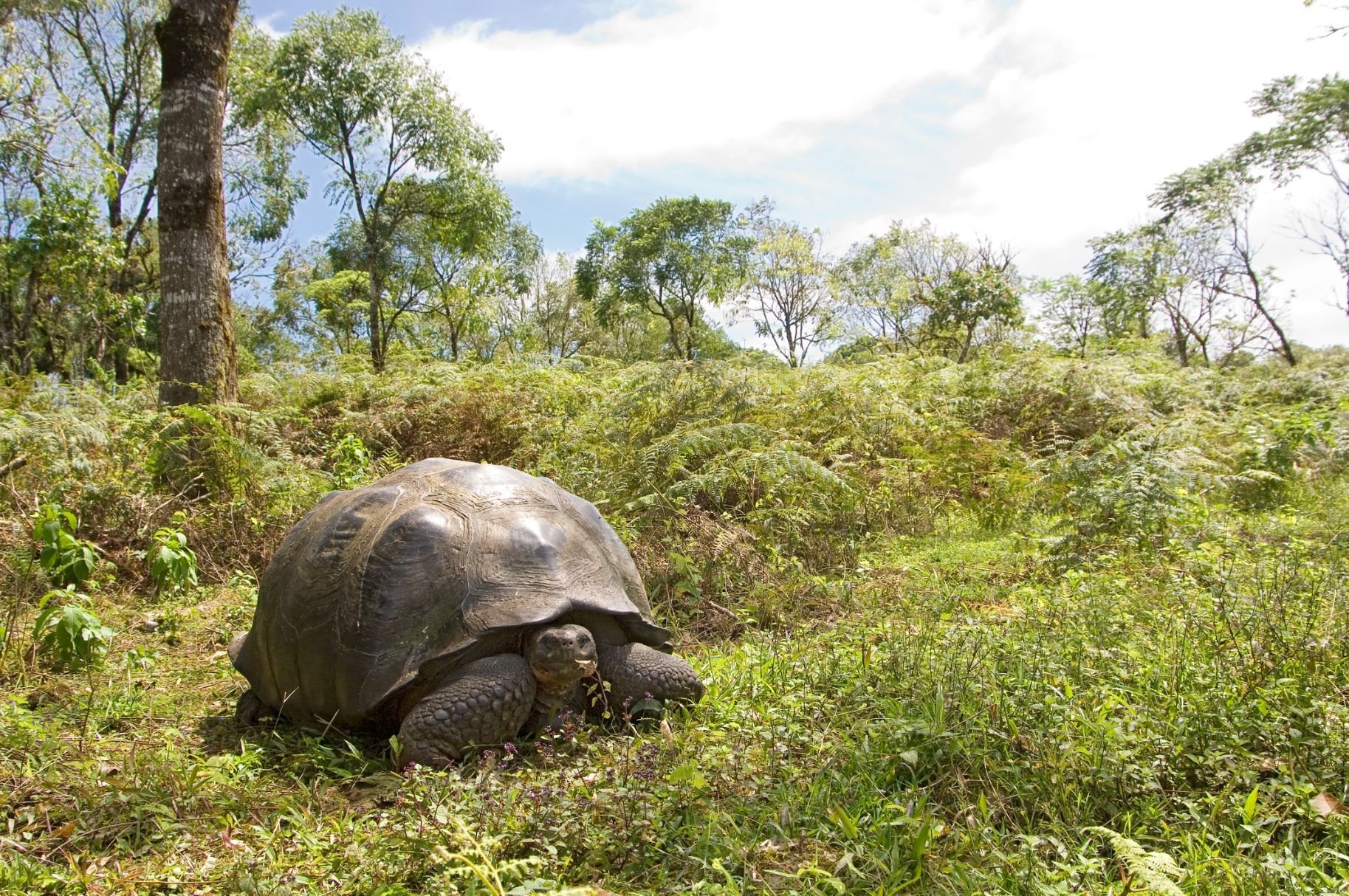
What animals could I see?: Galapagos giant tortoise, Galapagos barn owl, vermilion flycatcher, Galapagos dove, Galapagos short-eared owl
El Chato is a cattle ranch in the Santa Cruz highlands that became a gathering place for giant tortoises (due to the abundance of plants found on pastureland) - it’s now a private reserve with lots of free-roaming tortoises.
The 12-hectare reserve has walking trails amongst the vegetation, as well as intriguing lava tunnels to explore. Alongside the giant tortoises, keep a lookout for birds such as yellow warblers and vermillion flycatchers.
3. Relax at Tortuga Bay
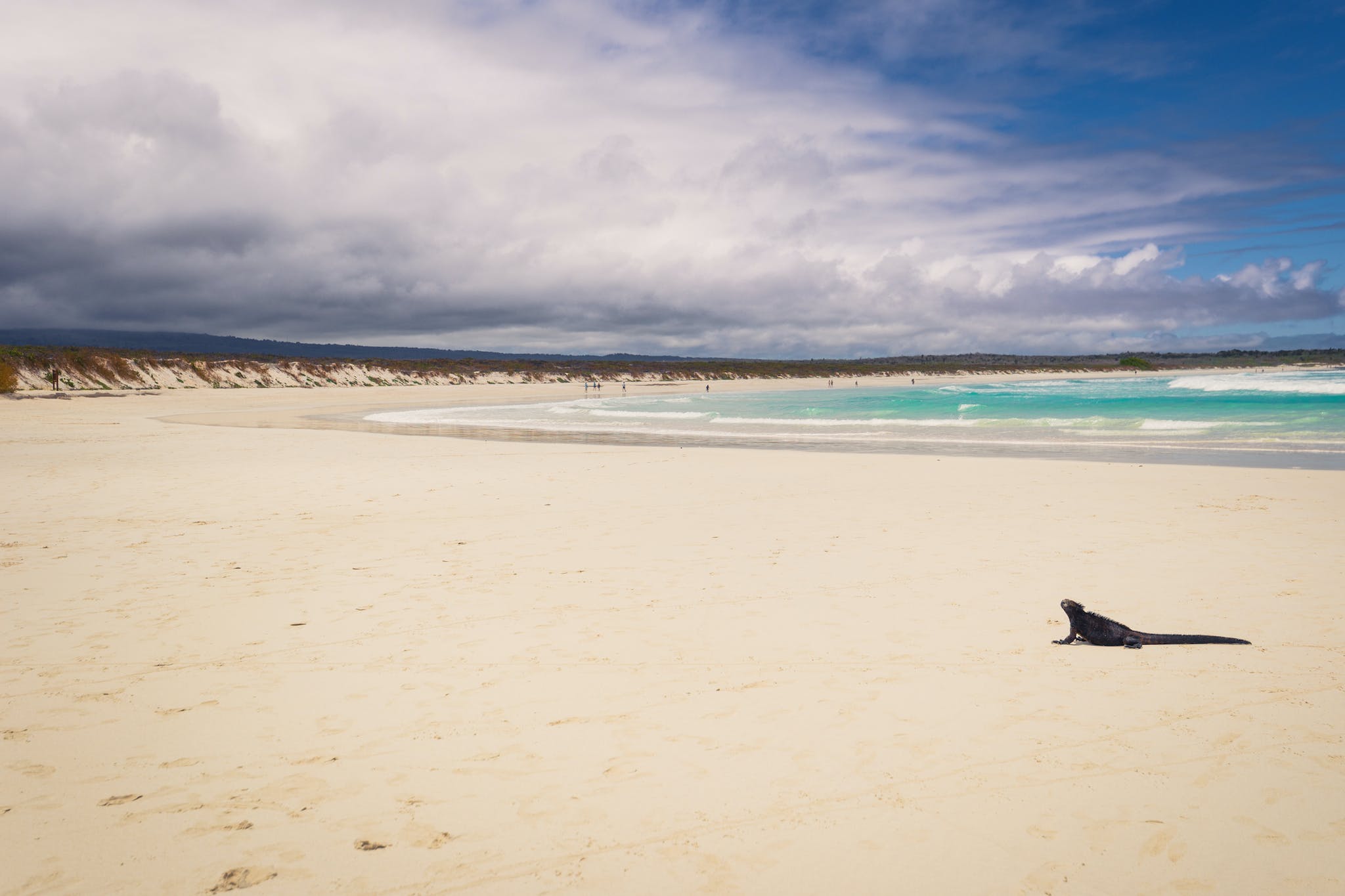
What animals could I see?: Galapagos green turtle, blue spotted booby, Galapagos brown pelican, Sally Lightfoot crab, reef shark, Galapagos marine iguana
One of the largest white sand beaches in the Galapagos, Santa Cruz island’s stunning Tortuga Bay is home to a variety of Galapagos island animals. These include the bright Sally Lightfoot crab and sea turtles who nest on the sand. You might even see some blue spotted boobies.
Tortuga Bay actually consists of two beaches - Playa Brava, the main beach, and the smaller Playa Mansa. The currents on Playa Brava make it unsafe for swimming, so take the 20-minute trail through the mangroves to the more sheltered Playa Mansa, where you can go swimming, snorkelling or even kayaking. The waters here are a good place to spot small reef sharks and marine iguanas.
4. Snorkel at Concha de Perla
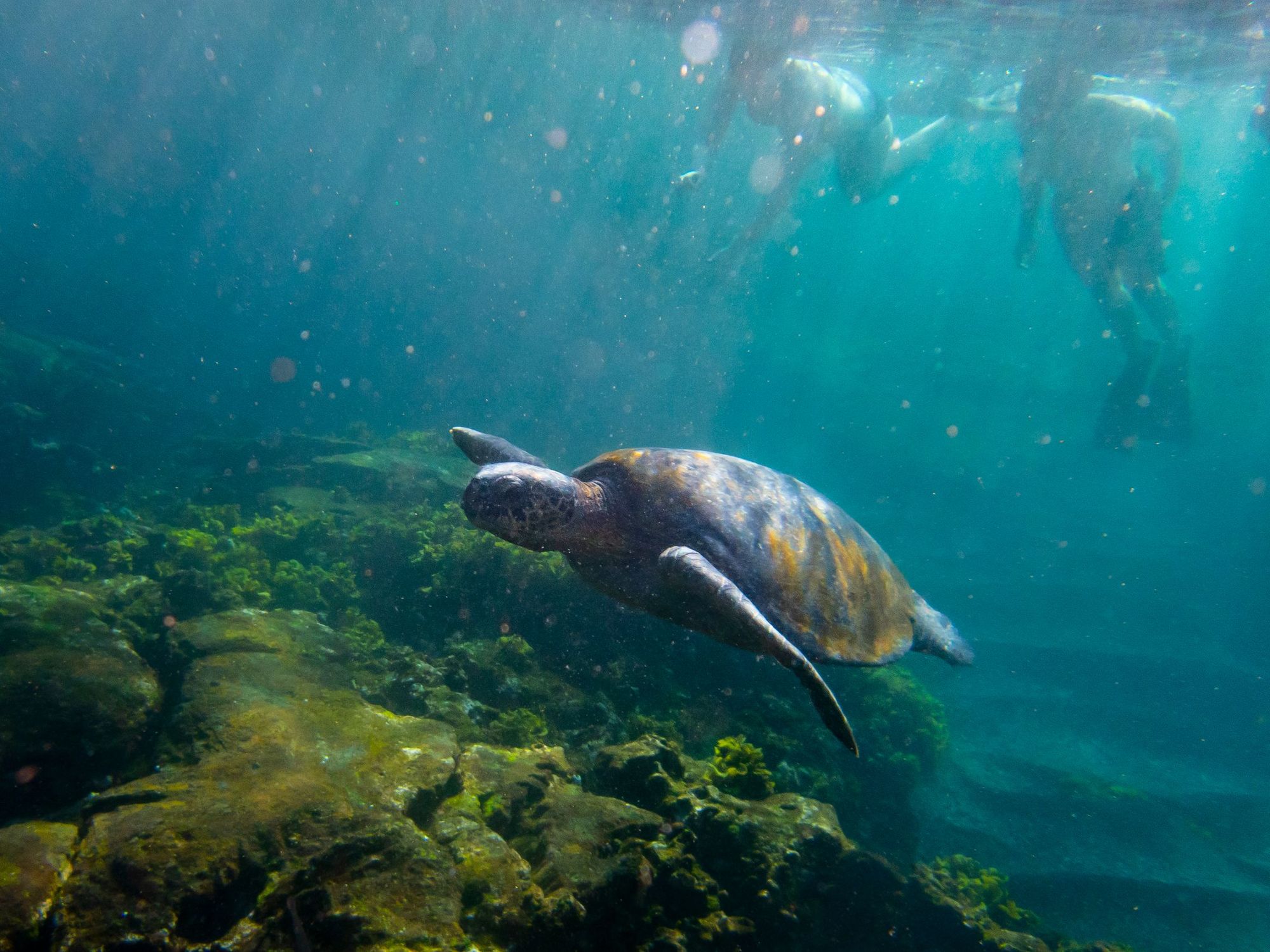
What animals could I see?: Galapagos sea lion, Galapagos penguin, flightless cormorant, Galapagos frigate bird, Galapagos marine iguana, Galapagos green turtle
Concha de Perla is a calm lagoon surrounded by a coral reef and fringed with mangroves, accessible via a boardwalk from Puerto Vilamel (on Isabela Island). It’s just outside the protected Galapagos Marine Reserve, meaning you can explore it without a guide.
"Depending on the tide, there are times when rays, sea turtles and whitetip sharks are trapped in this natural fish tank and the sharks choose the lava tunnel that is surrounded by mangrove as a resting place," says Wilson.
The lagoon is home to a variety of wildlife, including sea lions, penguins and the red-chested frigate birds. There are also lots of fish species in the lagoon, including butterfly fish, damselfish and diamond stingrays.
5. Take a Boat Trip around Islote las Tintoreras
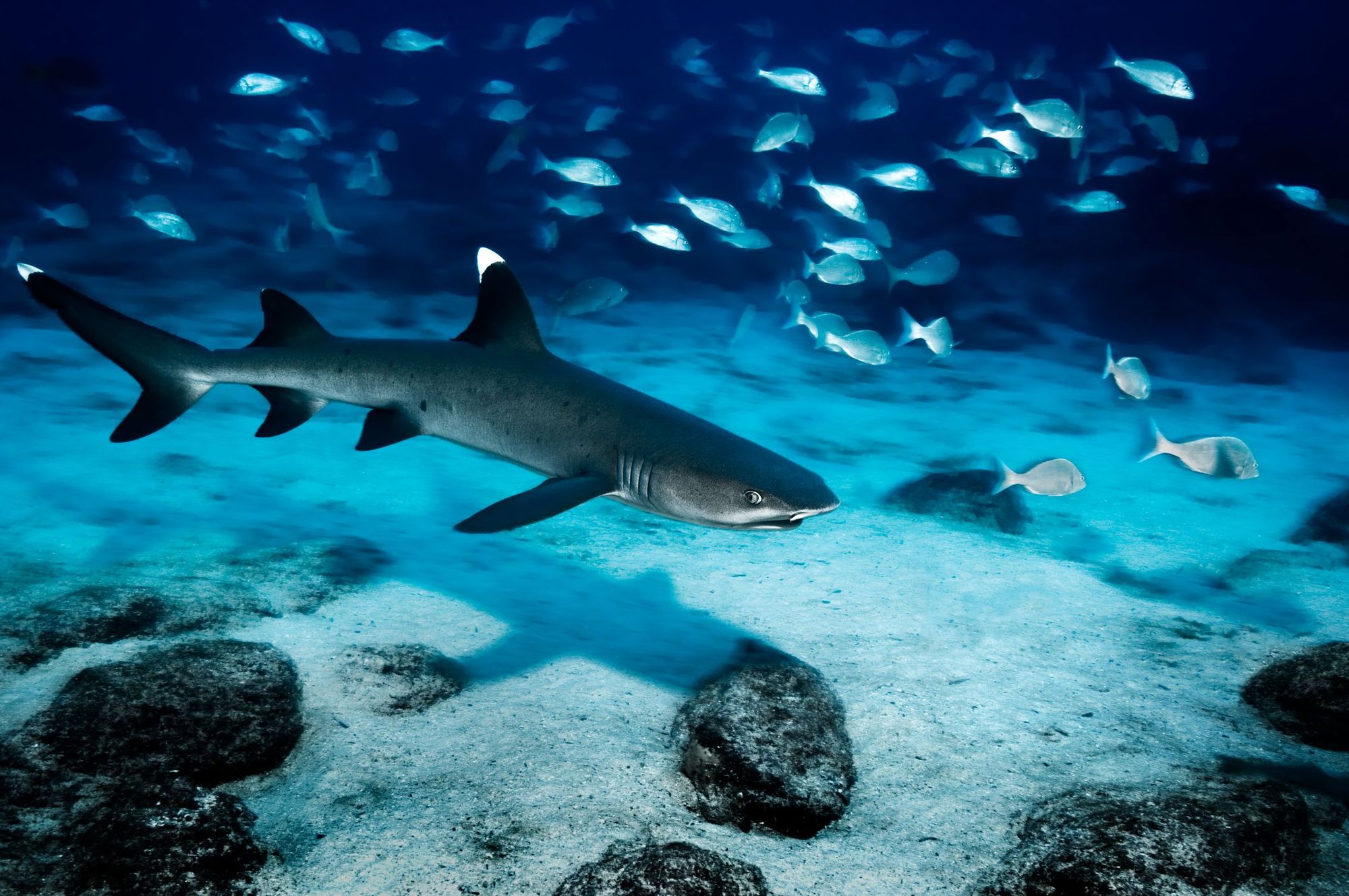
What animals could I see?: white-tipped reef sharks, blue-footed boobies, sea lions, Galapagos marine iguanas
Islote las Tintoreras is a chain of lava islets just off Isabela Island, named after the white-tipped reef sharks who live offshore. Take a boat trip around the bays of this wildlife haven, which is home to Galapagos penguins, blue-footed boobies, sea lions and marine iguanas.
Head to a site named The Cliff – a natural tunnel where reef sharks can often be seen resting. You can enjoy a snorkelling trip to see the sharks more closely, alongside manta rays and other fish species.
Wildlife Trips to the Galapagos Islands
Inspired? We are proud to run a number of responsible trips to the Galapagos islands where you'll have a chance to see these beautiful creates in their natural habitat. Check out our current trips here:


All of our trips start from Quito in Ecuador, which is easily accessible from international airports in the UK, US and Europe.


